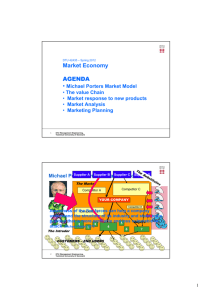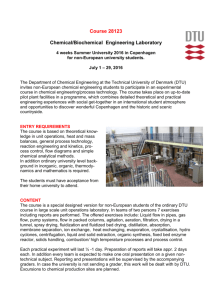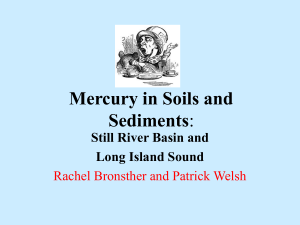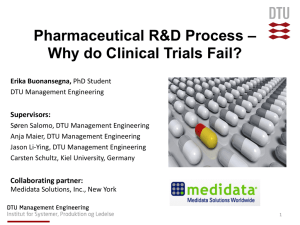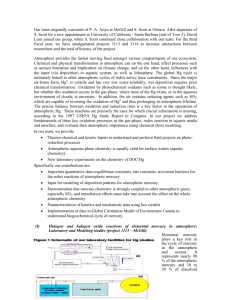Mercury Oxidation
advertisement
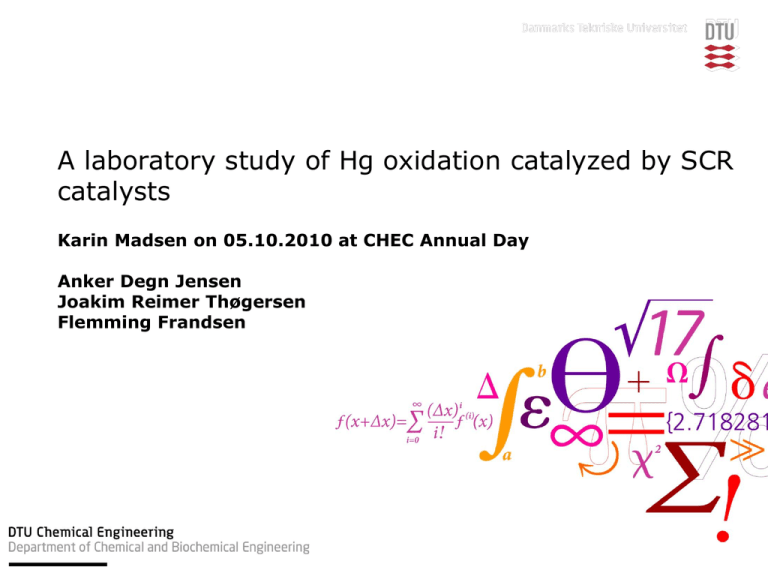
A laboratory study of Hg oxidation catalyzed by SCR catalysts Karin Madsen on 05.10.2010 at CHEC Annual Day Anker Degn Jensen Joakim Reimer Thøgersen Flemming Frandsen Outline • Background • Laboratory Study • Conclusions DTU Chemical Engineering Technical University of Denmark Background • 1930 tons of mercury was emitted in 2005 (Pacyna, 2010) – 45% comes from combustion of fossil fuels • Existing air pollution control devices offers an economically feasible option for mercury control • Mercury species in flue gases from power plants – Hg0 : Volatile, difficult to capture – Hg2+: Water soluble, can be captured in a wet scrubber – Hgp : Can be captured in particulate control devices • Mercury speciation is highly dependent on coal type/rank and operating conditions DTU Chemical Engineering Technical University of Denmark Mercury oxidation and the SCR • Mercury is oxidized by halogens in the flue gas • (Potential) net reaction Hg0 + 2 HCl + 1/2 O2 = HgCl2 + H2O • SCR catalysts for NOx-control also have catalytic activity on the mercury oxidation – The combination SCR + wet FGD can offer >90% mercury capture DTU Chemical Engineering Technical University of Denmark Laboratory Setup at Topsoe A/S Air Hg0 permeation tube (T=50°C) N2 H2O (T=17°C) NO SO2 Hg-analyser HCl Hg0 HgT DTU Chemical Engineering Technical University of Denmark NH3 HgReduction (T=750ºC) SCR Reactor Mercury oxidation and Chlorine DNX-catalyst, T=350ºC, NHSV=5800 h-1 , Hg0=40 µg/m3, NH3= 243 ppm, 1%H2O, 10%O2 Fraction Hg0 oxidized 1.00 0.90 0.80 0.70 0 2 4 6 HCl [ppm] DTU Chemical Engineering Technical University of Denmark 8 10 Mercury Oxidation and Ammonia -1 DNX-catalyst, T=350ºC, NHSV=5800 h , 0 Hg =40 µg/m3, HCl=1.6 ppm, H2O=1%, O2=10%, N2=balance Fraction Hg 0 oxidized 1.00 0.90 0.80 0.70 0 50 100 150 NH3 [ppm] DTU Chemical Engineering Technical University of Denmark 200 250 Mercury Oxidation: Laboratory versus Pilot-scale data Laboratory data Fraction Hg0 oxidized 1.00 Pilot-scale data (average) 0.75 0.50 0.25 0.00 0 50 HCl [ppm] DTU Chemical Engineering Technical University of Denmark 100 Conclusion: Close Gap between Laboratory and PilotScale Data • Difference in gas matrix – Laboratory Simulated flue gas containing Hg0, O2, H2O, NH3, HCl and N2 – Pilot Real flue gas from subbituminous coal combustion including NO, SO2, and fly ash • Factor 10-20 difference in catalyst activity must be due to difference in gas matrix • Future work involves testing of more complex gas matrices including NO and SO2 DTU Chemical Engineering Technical University of Denmark
